From front left, Wendy Jensen, Joe Woodmansee, Linda Holeman and Bonnie Dawson, the four children of Carole Rae Woodmansee, are joined by family friend Debbie Blazina, at right, Saturday, March 27, 2021, as they clean the headstone Carole shares with their father, Jim, who died in 2003, at Union Cemetery in Sedro-Woolley, Wash., north of Seattle, prior to a memorial service. Carole died a year ago on the same date in 2020, the day of her 81st birthday, from complications of COVID-19 after contracting it during a choir practice that sickened 53 people and killed two - a superspreader event that would become one of the most pivotal transmission episodes in understanding the virus. (AP Photo/Ted S. Warren)
The Associated Press
SEDRO-WOOLLEY, Wash. (AP) - With dish soap, brushes and plastic water jugs in hand, Carole Rae Woodmansee's four children cleaned the gravestone their mother shares with their father, Jim. Each scrub shined engraved letters spelling out their mother's name and the days of her birth and death: March 27, 1939, and March 27, 2020.
Carole passed away on her 81st birthday.
That morning marked a year since she died of complications of COVID-19 after contracting it during a choir practice that sickened 53 people and killed two - a superspreader event that would become one of the most pivotal transmission episodes in understanding the virus.
For the siblings, the somber anniversary offered a chance at closure after the pandemic stunted their mourning. They were finally holding a memorial befitting of their mother's footprint in the community.
'œThe hardest thing is that there was no goodbye. It was like she just disappeared,'ť said Carole's youngest child, Wendy Jensen.
After cleaning, the siblings reminisce. They say their father must be happy to be back with his wife of 46 years. They thank them for being good parents and recall how their mother used to say 'œmy'ť before calling their names and those of other loved ones.
'œI was always '~My Bonnie,''ť Bonnie Dawson tells her siblings. 'œI miss being '~My Bonnie.''ť
'œShe had been missing Dad for a long time,'ť eldest sibling Linda Holeman adds. Their father, Jim, passed away in 2003.
Of the more than 550,000 people who have died of the virus in the United States, Carole was among the first. Her death came just weeks after the first reported outbreak at a nursing home in Kirkland, about an hour south of Mount Vernon. Carole, who survived heart surgery and cancer, had fallen ill at her home. Bonnie took care of her until they called the paramedics.
'œYou're trying to say goodbye to your mom, and they're telling you to get back. It was a very hard, emotional '¦ to have to yell, '~I love you, Mom,' as she's being wheeled out the door with men standing in our yard 10 feet out because they didn't want to be near our house,'ť Bonnie said.
The rehearsal of the Skagit Valley Chorale, a community choir made up mostly of retirees and not associated with the church where they practiced, happened two weeks before Gov. Jay Inslee shut down the state. The choir had taken the precautions known at the time, such as distancing themselves and sanitizing. But someone had the virus.
'œThe choir themselves called us directly, and they left a voicemail. The voicemail said a positive person in the choir, 24 people now sick,'ť said Lea Hamner, communicable disease and epidemiology lead for Skagit County Public Health. 'œIt was immediately evident that we had a big problem.'ť
Hamner and her team went to work interviewing choir members, often repeatedly, and those with whom they came in contact after the practice, a total of 122 people. They meticulously pieced together the evening, tracking things like where people sat and who ate cookies or stacked chairs.
That level of access and detail is rare among outbreak investigations, Hamner said, so when cases waned in the county a few weeks later, she sat down to write a report.
'œThere was a lot of resistance to calling it an airborne disease,'ť Hamner said. 'œBut we found this middle ground of this disease that can both be droplet and airborne. So that was a big shift. After the paper, the CDC started to acknowledge airborne transmission.'ť
The outbreak had gained notoriety after a Los Angeles Times article, prompting other researchers to study the event and further cementing the conclusion about how the virus traveled during the rehearsal.
'œI think this outbreak in the choir is viewed '¦ as the one event that really woke people up to the idea that the virus could be spreading through the air,'ť said Linsey Marr, a Virginia Tech professor and expert in airborne transmission. Marr was among 239 experts who successfully lobbied the World Health Organization to change its guidelines on transmission.
The other person who died from the choir practice was 83-year-old Nancy 'œNicki'ť Hamilton. Originally from New York, Hamilton settled north of Seattle in the 1990s. She put out a personal ad in the Everett Herald, and that's how she met her husband.
'œWe went down to the bowling alley in Everett,'ť said 85-year-old Victor Hamilton. 'œWe picked it up from there.'ť
Hamilton hasn't been able to hold a memorial for her. Their families are spread throughout the country, and he'd like to have it in New York City if possible. He's eyeing June 21 - her birthday.
In nearby Mount Vernon, family and friends stream into Radius Church, gazing at an installation of a few dozen photos of Carole that the siblings put together. Wendy also displays a quilt her daughter made using Carole's music camp T-shirts.
Pastor Ken Hubbard tells attendees the service isn't really a funeral but a memorial, a chance to share stories about Carole.
'œI'm pretty sure her prayers saved my life a time or two,'ť grandson David Woodmansee says.
Loved ones recall Carole's devotion to her family, faith and music. Others remember how she welcomed them into her family, gave piano lessons and did volunteer work for her church.
They sing 'œBlessed Assurance,'ť her favorite hymn. Its lyrics were among her last words to her children from the hospital.
After the service, the family returns to the cemetery to lay flowers. They sing again too, closing the day with a spontaneous, smile-filled rendition of 'œHappy Birthday.'ť
Later, Wendy reflects on the choir practice where her mother contracted the virus, noting the knowledge gained from it that helped advance preventative measures.
'œAs far as we know, that was God's plan, for her to be a help in that.'ť
'œI think my mom would be willing to give up her life in order to save lives," Bonnie said. 'œThat was the kind of person she was.'ť
Wendy Jensen, one of the four children of Carole Rae Woodmansee, cleans the headstone Carole shares with their father Jim (who died in 2003), Saturday, March 27, 2021, at Union Cemetery in Sedro-Woolley, Wash., prior to a memorial service. Carole died a year ago on the same date in 2020 - the day of her 81st birthday - from complications of COVID-19 after contracting it during a choir practice that sickened 53 people and killed two - a superspreader event that would become one of the most pivotal transmission episodes in understanding the virus. (AP Photo/Ted S. Warren)
The Associated Press

Flowers from her memorial service mark the headstone shared by Carole Rae Woodmansee and her husband Jim (who died in 2003), Saturday, March 27, 2021, at Union Cemetery in Sedro-Woolley, Wash., north of Seattle. Carole died a year ago on the same date in 2020 - the day of her 81st birthday - from complications of COVID-19 after contracting it during a choir practice that sickened 53 people and killed two - a superspreader event that would become one of the most pivotal transmission episodes in understanding the virus. (AP Photo/Ted S. Warren)
The Associated Press
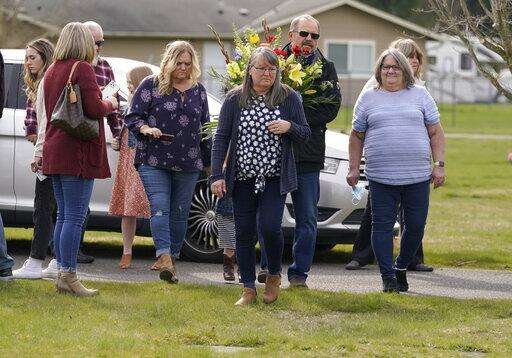
Bonnie Dawson, center, walks with her siblings Wendy Jensen, center left, Joe Woodmansee, center right, and Linda Holeman, right, as they carry flowers from a memorial service to the headstone of their mother, Carole Rae Woodmansee, at Union Cemetery in Sedro-Woolley, Wash., north of Seattle. Carole died a year ago on the same date in 2020, the day of her 81st birthday, from complications of COVID-19 after contracting it during a choir practice that sickened 53 people and killed two - a superspreader event that would become one of the most pivotal transmission episodes in understanding the virus. (AP Photo/Ted S. Warren)
The Associated Press

Joe Woodmansee holds a photo of the last time he and his three siblings were together with their mother, Carole Rae Woodmansee, as he visits Carole's grave, Saturday, March 27, 2021, at Union Cemetery in Sedro-Woolley, Wash., north of Seattle, prior to a memorial service. Carole died a year ago on the same date in 2020 - the day of her 81st birthday - from complications of COVID-19 after contracting it during a choir practice that sickened 53 people and killed two - a superspreader event that would become one of the most pivotal transmission episodes in understanding the virus. (AP Photo/Ted S. Warren)
The Associated Press

Wendy Jensen, left, helps her granddaughter Abby Jensen, place items at the headstone of Wendy's mother, Carole Rae Woodmansee, at Union Cemetery in Sedro-Woolley, Wash., north of Seattle. Carole died a year ago on the same date in 2020 - the day of her 81st birthday - from complications of COVID-19 after contracting it during a choir practice that sickened 53 people and killed two - a superspreader event that would become one of the most pivotal transmission episodes in understanding the virus. (AP Photo/Ted S. Warren)
The Associated Press
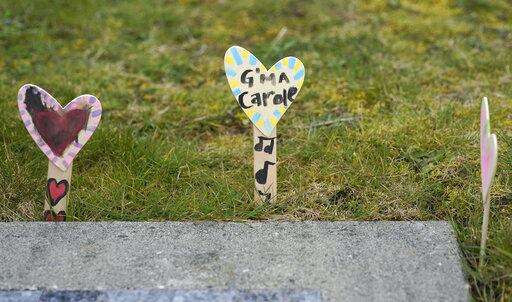
Hearts crafted by a grand-daughter line the headstone of Carole Rae Woodmansee at Union Cemetery in Sedro-Woolley, Wash., north of Seattle. Carole died a year ago on the same date in 2020 - the day of her 81st birthday - from complications of COVID-19 after contracting it during a choir practice that sickened 53 people and killed two - a superspreader event that would become one of the most pivotal transmission episodes in understanding the virus. (AP Photo/Ted S. Warren)
The Associated Press

Family members and friends attend a memorial service, Saturday, March 27, 2021, for Carole Rae Woodmansee at Radius Church in Mount Vernon, Wash. Woodmansee died a year ago on the same date in 2020 - the day of her 81st birthday - from complications of COVID-19 after contracting it during a choir practice that sickened 53 people and killed two - a superspreader event that would become one of the most pivotal transmission episodes in understanding the virus. (AP Photo/Ted S. Warren)
The Associated Press

A photo of Carole Rae Woodmansee and her husband Jim (who died in 2003) is shown on a display at Radius Church in Mount Vernon, Wash., Saturday, March 27, 2021, prior to a memorial service for Carole, who died a year ago on the same date in 2020 - the day of her 81st birthday - from complications of COVID-19 after contracting it during a choir practice that sickened 53 people and killed two. The practice turned out to be a superspreader event that would become one of the most pivotal transmission episodes in understanding the virus. (AP Photo/Ted S. Warren)
The Associated Press

Photos of Carole Rae Woodmansee are shown on a display at Radius Church in Mount Vernon, Wash., Saturday, March 27, 2021, prior to a memorial service for Woodmansee, who died a year ago on the same date in 2020 - the day of her 81st birthday - from complications of COVID-19 after contracting it during a choir practice that sickened 53 people and killed two. The practice turned out to be a superspreader event that would become one of the most pivotal transmission episodes in understanding the virus. (AP Photo/Ted S. Warren)
The Associated Press
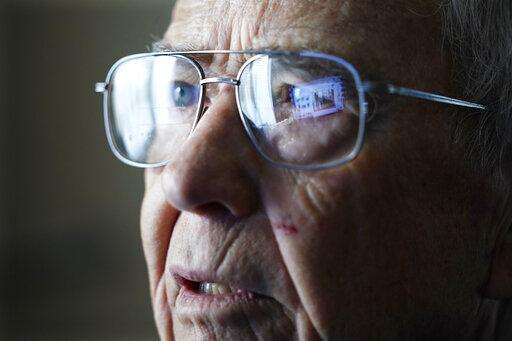
Victor Hamilton looks over photos on a computer screen of his late wife, Nancy "Nicki" Hamilton, who died about a year earlier after contracting COVID-19 at a choir practice, Thursday, April 8, 2021, at his home in Mount Vernon, Wash. The choir practice in Washington state sickened 53 people and killed two, becoming one of the first known COVID-19 superspreader events in the United States. But from that tragic toll emerged one of the most pivotal transmission episodes in understanding that the virus was spreading through the air. (AP Photo/Elaine Thompson)
The Associated Press
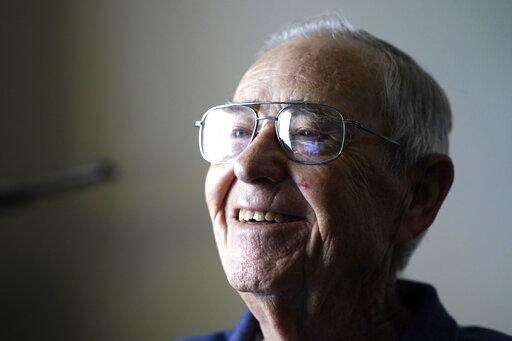
Victor Hamilton smiles as he talks about his late wife, Nancy "Nicki" Hamilton, who died about a year earlier after contracting COVID-19 at a choir practice, Thursday, April 8, 2021, at his home in Mount Vernon, Wash. The choir practice in Washington state sickened 53 people and killed two, becoming one of the first known COVID-19 superspreader events in the United States. But from that tragic toll emerged one of the most pivotal transmission episodes in understanding that the virus was spreading through the air. (AP Photo/Elaine Thompson)
The Associated Press
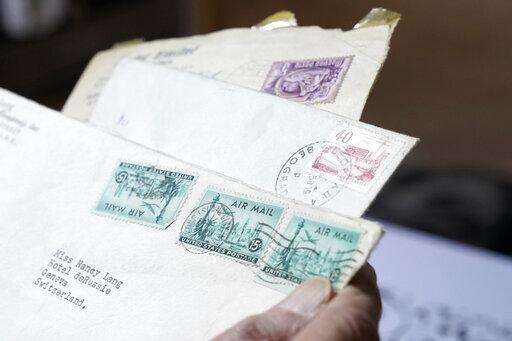
Victor Hamilton looks over stamps collected by his late wife, Nancy "Nicki" Hamilton, who died about a year earlier after contracting COVID-19 at a choir practice, Thursday, April 8, 2021, at his home in Mount Vernon, Wash. The choir practice in Washington state sickened 53 people and killed two, becoming one of the first known COVID-19 superspreader events in the United States. But from that tragic toll emerged one of the most pivotal transmission episodes in understanding that the virus was spreading through the air. (AP Photo/Elaine Thompson)
The Associated Press
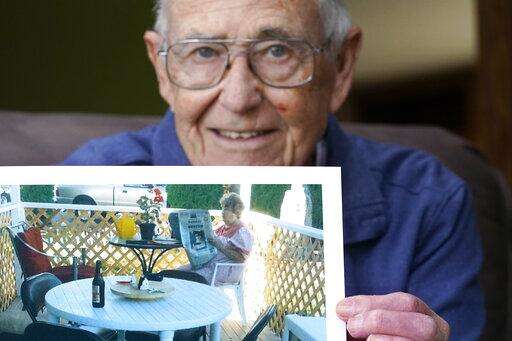
Victor Hamilton displays a photo of his late wife, Nancy "Nicki" Hamilton, who died about a year earlier after contracting COVID-19 at a choir practice, Thursday, April 8, 2021, at his home in Mount Vernon, Wash. The choir practice in Washington state sickened 53 people and killed two, becoming one of the first known COVID-19 superspreader events in the United States. But from that tragic toll emerged one of the most pivotal transmission episodes in understanding that the virus was spreading through the air. (AP Photo/Elaine Thompson)
The Associated Press

Victor Hamilton talks with a visitor about plans for an upcoming memorial service for his late wife, Nancy "Nicki" Hamilton, who died about a year earlier after contracting COVID-19 at a choir practice, Thursday, April 8, 2021, at his home in Mount Vernon, Wash. The choir practice in Washington state sickened 53 people and killed two, becoming one of the first known COVID-19 superspreader events in the United States. But from that tragic toll emerged one of the most pivotal transmission episodes in understanding that the virus was spreading through the air. (AP Photo/Elaine Thompson)
The Associated Press
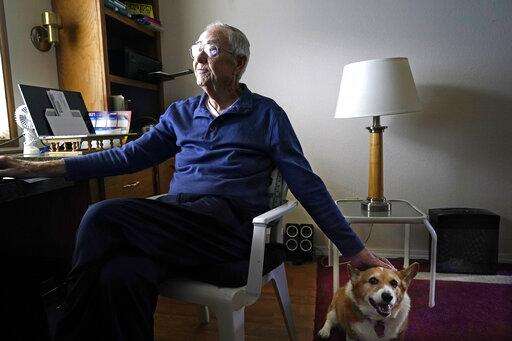
Victor Hamilton reaches back to pet his dog Charlie as he talks about his late wife, Nancy "Nicki" Hamilton, who died about a year earlier after contracting COVID-19 at a choir practice, Thursday, April 8, 2021, at his home in Mount Vernon, Wash. The choir practice in Washington state sickened 53 people and killed two, becoming one of the first known COVID-19 superspreader events in the United States. But from that tragic toll emerged one of the most pivotal transmission episodes in understanding that the virus was spreading through the air. (AP Photo/Elaine Thompson)
The Associated Press
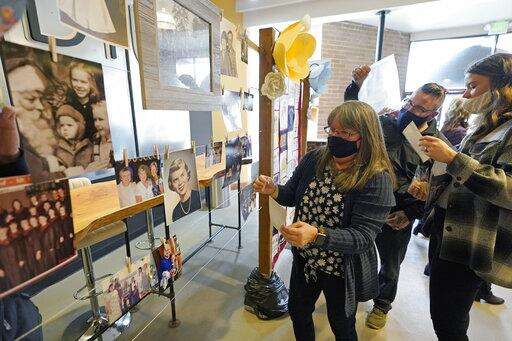
Bonnie Dawson, center, helps place photos of her mother, Carole Rae Woodmansee, on a display at Radius Church in Mount Vernon, Wash., Saturday, March 27, 2021, prior to a memorial service for Woodmansee, who died a year ago on the same date in 2020 - the day of her 81st birthday - from complications of COVID-19 after contracting it during a choir practice that sickened 53 people and killed two. The practice turned out to be a superspreader event that would become one of the most pivotal transmission episodes in understanding the virus. (AP Photo/Ted S. Warren)
The Associated Press

Lea Hamner, the communicable disease and epidemiology lead for Skagit County Public Health, poses for a photo, Wednesday, March 17, 2021, outside her office in Mount Vernon, Wash. Hamner was part of the team that authored the report she is holding that studied a choir practice that led to 53 people being sickened with COVID-19 and two dying from it- a superspreader event that would become one of the most pivotal transmission episodes in understanding the virus. (AP Photo/Ted S. Warren)
The Associated Press
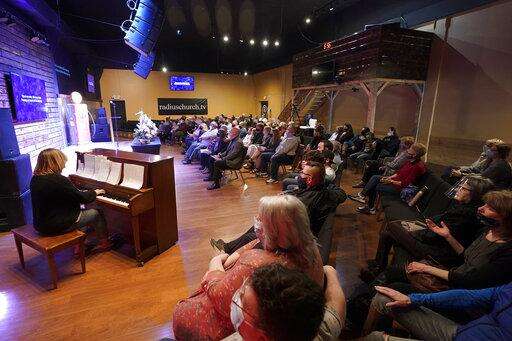
Family members and friends attend a memorial service, Saturday, March 27, 2021, for Carole Rae Woodmansee at Radius Church in Mount Vernon, Wash. Woodmansee died a year ago on the same date in 2020 - the day of her 81st birthday - from complications of COVID-19 after contracting it during a choir practice that sickened 53 people and killed two - a superspreader event that would become one of the most pivotal transmission episodes in understanding the virus. (AP Photo/Ted S. Warren)
The Associated Press
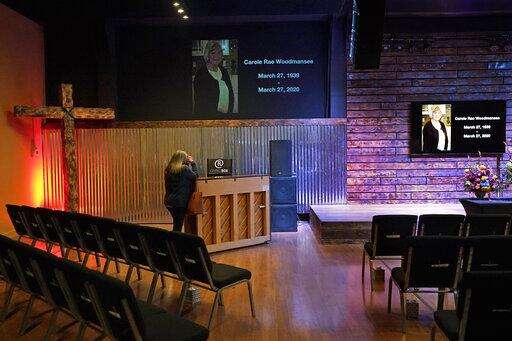
Bonnie Dawson leans on a piano as she takes a moment to reflect in an empty chapel prior to a memorial service for her mother, Carole Rae Woodmansee, Saturday, March 27, 2021, at Radius Church in Mount Vernon, Wash. Carole died a year ago on the same date in 2020 - the day of her 81st birthday - from complications of COVID-19 after contracting it during a choir practice that sickened 53 people and killed two - a superspreader event that would become one of the most pivotal transmission episodes in understanding the virus. (AP Photo/Ted S. Warren)
The Associated Press
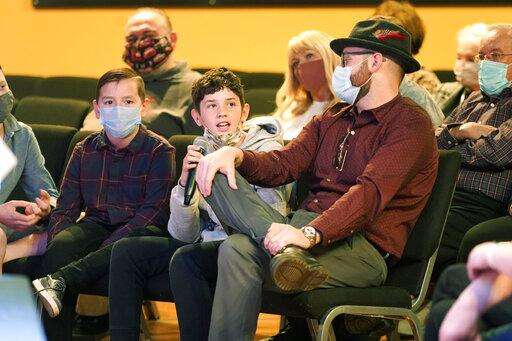
Grady Woodmansee, center, talks about his great-grandmother Carole Rae Woodmansee as he sits with his uncle David Woodmansee, right, and his cousin Rex Woodmansee, left, at a memorial service, Saturday, March 27, 2021, at Radius Church in Mount Vernon, Wash. Carole died a year ago on the same date in 2020, the day of her 81st birthday, from complications of COVID-19 after contracting it during a choir practice that sickened 53 people and killed two - a superspreader event that would become one of the most pivotal transmission episodes in understanding the virus. (AP Photo/Ted S. Warren)
The Associated Press
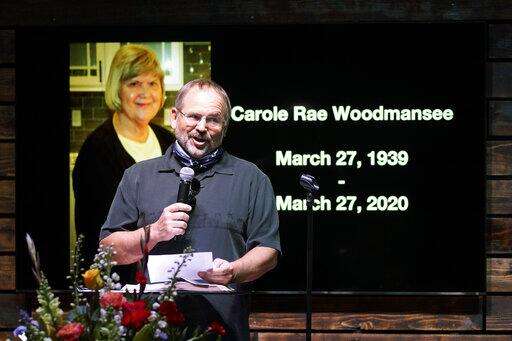
Joe Woodmansee speaks at a memorial service for his mother, Carole Rae Woodmansee, Saturday, March 27, 2021, at Radius Church in Mount Vernon, Wash. Carole died a year ago on the same date in 2020 - the day of her 81st birthday - from complications of COVID-19 after contracting it during a choir practice that sickened 53 people and killed two - a superspreader event that would become one of the most pivotal transmission episodes in understanding the virus. (AP Photo/Ted S. Warren)
The Associated Press
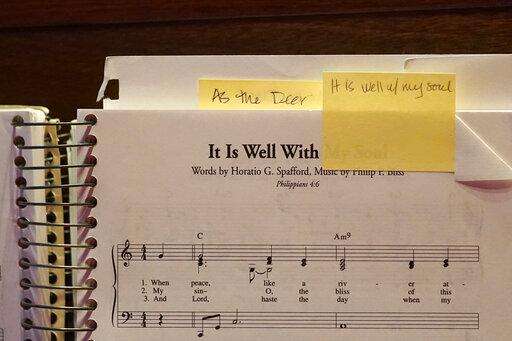
Music for the hymn "It is Well With my Soul" rests on a piano at a memorial service for Carole Rae Woodmansee, Saturday, March 27, 2021, at Radius Church in Mount Vernon, Wash. Words from the hymn were among the last words spoken by Carole, when she died a year ago on the same date in 2020 - the day of her 81st birthday - from complications of COVID-19 after contracting it during a choir practice that sickened 53 people and killed two - a superspreader event that would become one of the most pivotal transmission episodes in understanding the virus. (AP Photo/Ted S. Warren)
The Associated Press
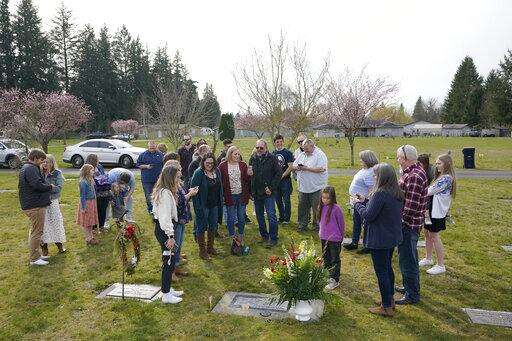
Family members and friends sing as they gather around the headstone Carole Rae Woodmansee shares with her husband Jim (who died in 2003) at Union Cemetery in Sedro-Woolley, Wash., north of Seattle, following a memorial service March 27, 2021. Carole died a year ago on the same date in 2020 - the day of her 81st birthday - from complications of COVID-19 after contracting it during a choir practice that sickened 53 people and killed two - a superspreader event that would become one of the most pivotal transmission episodes in understanding the virus. (AP Photo/Ted S. Warren)
The Associated Press
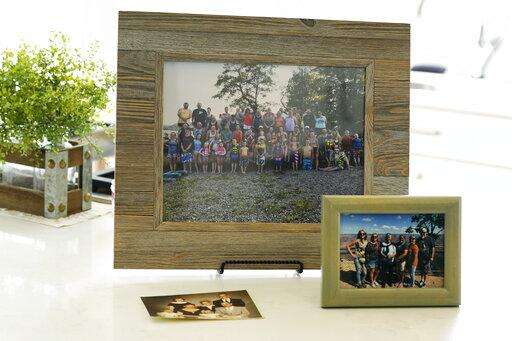
Family photos of Carole Rae Woodmansee and her descendants are displayed at the home of Carole's son, Joe Woodmansee, Wednesday, March 17, 2021, in Mount Vernon, Wash. Carole died March 27, 2020, the day of her 81st birthday, from complications of COVID-19 after contracting it during a choir practice that sickened 53 people and killed two. The practice turned out to be a superspreader event that would become one of the most pivotal transmission episodes in understanding the virus. (AP Photo/Ted S. Warren)
The Associated Press
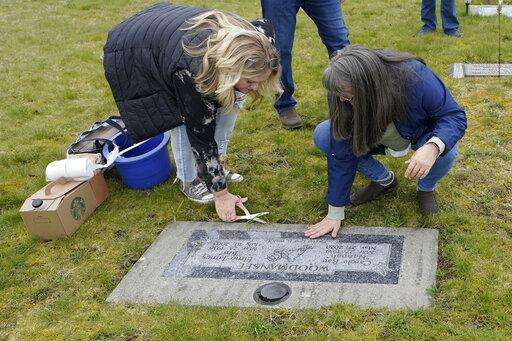
Wendy Jensen, left, and Bonnie Dawson, right, two of the four children of Carole Rae Woodmansee, trim grass and clean the headstone Carole shares with their father Jim (who died in 2003), Saturday, March 27, 2021, at Union Cemetery in Sedro-Woolley, Wash., prior to a memorial service. Carole died a year ago on the same date in 2020 - the day of her 81st birthday - from complications of COVID-19 after contracting it during a choir practice that sickened 53 people and killed two - a superspreader event that would become one of the most pivotal transmission episodes in understanding the virus. (AP Photo/Ted S. Warren)
The Associated Press